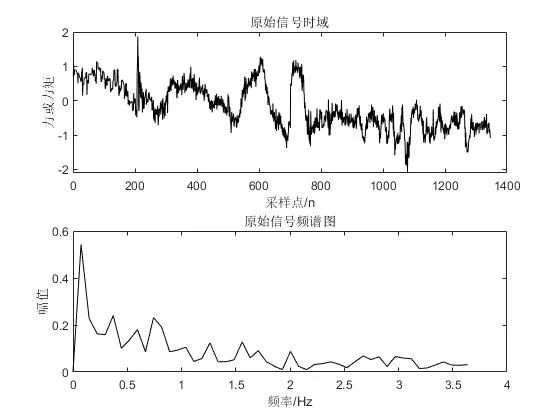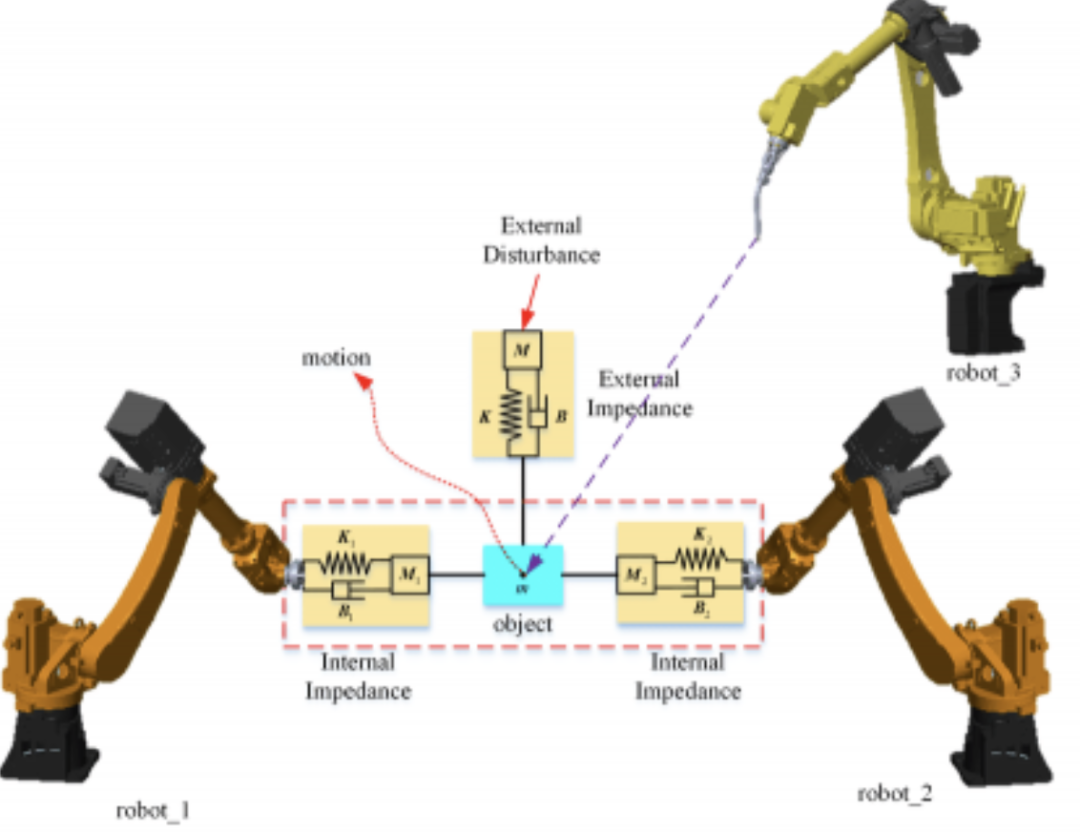下面舉一些例子,實(shí)現(xiàn)對機(jī)器人接觸力的數(shù)據(jù)濾波!
首先是導(dǎo)入數(shù)據(jù):
clc
clear all;
close all;
X = xlsread('E:程序test~六維力數(shù)據(jù).csv');%導(dǎo)入數(shù)據(jù)
A=X(:,1);B=X(:,2);C=X(:,3);D=X(:,4);E=X(:,5);F=X(:,6);%提取力數(shù)據(jù)
%% 濾波
x=A;
N=1347; %時域點(diǎn)數(shù)
fs = 100; % 重采樣頻率
T = 1/fs; % 周期
n = 5; % 1Hz頻率被分成n段
% N = fs*n; % 因?yàn)?span id="5vgeo944t" class="hljs-number">1Hz頻率被分成了n段,所以頻譜的x軸數(shù)組有fs*n個數(shù)
f = (0: N-1)*fs/N; % 將fs個頻率細(xì)分成fs*n個(即原來是[0, 1, 2, …, fs],現(xiàn)在是[0, 1/N, 2/N, …, (N-1)*fs/N])
t = (0: N-1)*T; % 信號所持續(xù)的時長(N個周期)
nHz = 10; % 畫的頻譜的橫坐標(biāo)到nHz
Hz = nHz*n; % 畫的頻譜的橫坐標(biāo)的數(shù)組個數(shù)
%% 繪制原始信號時頻圖
figure
subplot(211),plot(x,'k'),title('原始信號時域'),xlabel('采樣點(diǎn)/n'),ylabel('力或力矩'); % 繪制原始信號時域
fx = abs(fft(x-mean(x)))/(N/2); % 傅里葉變換
subplot(212),plot(f(1:Hz), fx(1:Hz),'k'),title('原始信號頻譜圖'),xlabel('頻率/Hz'),ylabel('幅值'); % 繪制原始信號頻域
可以得到如下結(jié)果:

通過傅里葉變換可以得到接觸力信號頻域上的內(nèi)容。
進(jìn)行低通濾波處理:
%% 低通濾波
fc = 20;
Wc = 2*fc/fs;
[b,a] = butter(2,Wc,'low'); % 四階的巴特沃斯低通濾波,保留頻率低于fc的振動
fprintf('a = %6.18fn',a);
fprintf('b = %6.18fn',b);
x1 = filter(b,a,x);
figure
subplot(211),plot(x1,'b'),title('低通濾波信號時域圖'),xlabel('采樣點(diǎn)/n'),ylabel('力或力矩');
fx = abs(fft(x1-mean(x1)))/(N/2); % 傅里葉變換
subplot(212),plot(f(1:Hz), fx(1:Hz),'b'),title('低通濾波信號頻譜圖'),xlabel('頻率/Hz'),ylabel('幅值'); % 繪制原始信號頻域
Butterworth digital and analog filter design:
function varargout = butter(n, Wn, varargin)
narginchk(2,4);
if coder.target('MATLAB')
[varargout{1:nargout}] = butterImpl(n,Wn,varargin{:});
else
allConst = coder.internal.isConst(n) && coder.internal.isConst(Wn);
for ii = 1:length(varargin)
allConst = allConst && coder.internal.isConst(varargin{ii});
end
if allConst && coder.internal.isCompiled
[varargout{1:nargout}] = coder.const(@feval,'butter',n,Wn,varargin{:});
else
[varargout{1:nargout}] = butterImpl(n,Wn,varargin{:});
end
end
end
function varargout = butterImpl(n,Wn,varargin)
inputArgs = cell(1,length(varargin));
if nargin > 2
[inputArgs{:}] = convertStringsToChars(varargin{:});
else
inputArgs = varargin;
end
validateattributes(n,{'numeric'},{'scalar','real','integer','positive'},'butter','N');
validateattributes(Wn,{'numeric'},{'vector','real','finite','nonempty'},'butter','Wn');
[btype,analog,~,msgobj] = iirchk(Wn,inputArgs{:});
if ~isempty(msgobj)
coder.internal.error(msgobj.Identifier,msgobj.Arguments{:});
end
% Cast to enforce precision rules
n1 = double(n(1));
coder.internal.errorIf(n1 > 500,'signal:butter:InvalidRange')
% Cast to enforce precision rules
Wn = double(Wn);
% step 1: get analog, pre-warped frequencies
fs = 2;
if ~analog
u = 2*fs*tan(pi*Wn/fs);
else
u = Wn;
end
% step 2: Get N-th order Butterworth analog lowpass prototype
[zs,ps,ks] = buttap(n1);
% Transform to state-space
[a,b,c,d] = zp2ss(zs,ps,ks);
% step 3: Transform to the desired filter
if length(Wn) == 1
% step 3a: convert to low-pass prototype estimate
Wn1 = u(1);
Bw = []; %#ok< NASGU >
% step 3b: Transform to lowpass or high pass filter of desired cutoff
% frequency
if btype == 1 % Lowpass
[ad,bd,cd,dd] = lp2lp(a,b,c,d,Wn1);
else % btype == 3 % Highpass
[ad,bd,cd,dd] = lp2hp(a,b,c,d,Wn1);
end
else % length(Wn) is 2
% step 3a: convert to low-pass prototype estimate
Bw = u(2) - u(1); % center frequency
Wn1 = sqrt(u(1)*u(2));
% step 3b: Transform to bandpass or bandstop filter of desired center
% frequency and bandwidth
if btype == 2 % Bandpass
[ad,bd,cd,dd] = lp2bp(a,b,c,d,Wn1,Bw);
else % btype == 4 % Bandstop
[ad,bd,cd,dd] = lp2bs(a,b,c,d,Wn1,Bw);
end
end
% step 4: Use Bilinear transformation to find discrete equivalent:
if ~analog
[ad,bd,cd,dd] = bilinear(ad,bd,cd,dd,fs);
end
if nargout == 4 % Outputs are in state space form
varargout{1} = ad; % A
varargout{2} = bd; % B
varargout{3} = cd; % C
varargout{4} = dd; % D
else
p = eig(ad);
[z,k] = buttzeros(btype,n1,Wn1,analog,p+0i);
if nargout == 3 % Transform to zero-pole-gain form
varargout{1} = z;
varargout{2} = p;
varargout{3} = k;
else
den = real(poly(p));
num = [zeros(1,length(p)-length(z),'like',den) k*real(poly(z))];
varargout{1} = num;
varargout{2} = den;
end
end
end
function [z,k] = buttzeros(btype,n,Wn,analog,p)
% This internal function computes the zeros and gain of the ZPK
% representation. Wn is scalar (sqrt(Wn(1)*Wn(2)) for bandpass/stop).
if analog
% for lowpass and bandpass, don't include zeros at +Inf or -Inf
switch btype
case 1 % lowpass: H(0)=1
z = zeros(0,1,'like',p);
k = Wn^n; % prod(-p) = Wn^n
case 2 % bandpass: H(1i*Wn) = 1
z = zeros(n,1,'like',p);
k = real(prod(1i*Wn-p)/(1i*Wn)^n);
case 3 % highpass: H(Inf) = 1
z = zeros(n,1,'like',p);
k = 1;
case 4 % bandstop: H(0) = 1
z = 1i*Wn*((-1).^(0:2*n-1)');
k = 1; % prod(p) = prod(z) = Wn^(2n)
otherwise
coder.internal.error('signal:iirchk:BadFilterType','high','stop','low','bandpass');
end
else
Wn = 2*atan2(Wn,4);
switch btype
case 1 % lowpass: H(1)=1
z = -ones(n,1,'like',p);
k = real(prod(1-p))/2^n;
case 2 % bandpass: H(z) = 1 for z=exp(1i*sqrt(Wn(1)*Wn(2)))
z = [ones(n,1,'like',p); -ones(n,1,'like',p)];
zWn = exp(1i*Wn);
k = real(prod(zWn-p)/prod(zWn-z));
case 3 % highpass: H(-1) = 1
z = ones(n,1,'like',p);
k = real(prod(1+p))/2^n;
case 4 % bandstop: H(1) = 1
z = exp(1i*Wn*( (-1).^(0:2*n-1)' ));
k = real(prod(1-p)/prod(1-z));
otherwise
coder.internal.error('signal:iirchk:BadFilterType','high','stop','low','bandpass');
end
end
% Note: codegen complains when z set to both real and complex values above
if ~any(imag(z))
z = real(z);
end
end
可以得到濾波后的接觸力數(shù)據(jù):

為了更詳細(xì)的進(jìn)行原始數(shù)據(jù)與濾波后的數(shù)據(jù)進(jìn)行對比,接下來以幾種不同形式的濾波方式進(jìn)行對比。
原始接觸力數(shù)據(jù):

移動平均濾波
b = [1 1 1 1 1 1]/6;
x11 = filter(b,1,x);

很明顯,去除噪聲的效果較為突出!
接下來采用中值濾波:

中值濾波的效果相比于移動平均濾波有改善。
接下來進(jìn)行維納濾波:
Rxx=xcorr(x, x); %得到混合信號的自相關(guān)函數(shù)
M=100; %維納濾波器階數(shù)
for i=1:M
for j=1:M
rxx(i,j)=Rxx(abs(j-i)+N); %得到混合信號的自相關(guān)矩陣
end
end
Rxy=xcorr(x,x1); %(此處x1為中值信號濾波后效果,原信號不存在)得到混合信號和原信號的互相關(guān)函數(shù)
for i=1:M
rxy(i)=Rxy(i+N-1); %得到混合信號和原信號的互相關(guān)向量
end
h = inv(rxx)*rxy'; %得到所要涉及的wiener濾波器系數(shù)
x1=filter(h,1, x); %將輸入信號通過維納濾波器

但維納濾波的效果沒有前面兩個濾波算法的效果好,需要進(jìn)一步整定參數(shù)。
下面進(jìn)行自適應(yīng)濾波:
k=100; %時域抽頭LMS算法濾波器階數(shù)
u=0.001; %步長因子
%設(shè)置初值
x1=zeros(1,N); %output signal
x1(1:k)=x(1:k); %將輸入信號SignalAddNoise的前k個值作為輸出yn_1的前k個值
w=zeros(1,k); %設(shè)置抽頭加權(quán)初值
e=zeros(1,N); %誤差信號
%用LMS算法迭代濾波
for i=(k+1):N
XN=x((i-k+1):(i));
XN=XN';
x1(i)=w*XN';
e(i)=x11(i)-x1(i);%不存在原信號,此處換為平均濾波后的時域波形
w=w+2*u*e(i)*XN;
end

四階的巴特沃斯低通濾波:
Wc=2*3/fs; %截止頻率 3Hz
[b,a]=butter(4,Wc,'low'); % 四階的巴特沃斯低通濾波
x1=filter(b,a,x);

二階的巴特沃斯帶通濾波:
Wc1=2*1/fs; %下截止頻率 1Hz
Wc2=2*6/fs; %上截止頻率 6Hz
[b,a]=butter(2,[Wc1, Wc2],'bandpass'); % 二階的巴特沃斯帶通濾波
x1=filter(b,a,x);

需要生成濾波器時,可以使用matlab中自帶的工具。filterDesigner
利用這個工具,可以將設(shè)計的濾波器保存成一個函數(shù)。
-
機(jī)器人
+關(guān)注
關(guān)注
211文章
28597瀏覽量
207836 -
濾波
+關(guān)注
關(guān)注
10文章
669瀏覽量
56712 -
數(shù)據(jù)
+關(guān)注
關(guān)注
8文章
7118瀏覽量
89342
發(fā)布評論請先 登錄
相關(guān)推薦
nao機(jī)器人與其他機(jī)器人的區(qū)別
機(jī)器人彈鋼琴,實(shí)現(xiàn)難度如何?
機(jī)器人彈鋼琴
機(jī)器人、協(xié)作機(jī)器人和移動機(jī)器人,你分的清楚嗎
機(jī)器人的眼睛和大腦:智能化光電傳感器
機(jī)器人基礎(chǔ)書籍
軟固結(jié)磨粒群接觸力分析

機(jī)器人力控的性能指標(biāo)有哪些
機(jī)器人阻抗控制有幾種方法

力控機(jī)器人接觸力濾波與估計
單關(guān)節(jié)機(jī)械臂接觸力補(bǔ)償因素
機(jī)器臂柔順控制初步分析
柔性觸覺傳感器或?qū)⒃谌诵?b class='flag-5'>機(jī)器人時代大放異彩
接觸力對120A250A大電流接線端子有哪些影響





 如何實(shí)現(xiàn)對機(jī)器人接觸力的數(shù)據(jù)濾波
如何實(shí)現(xiàn)對機(jī)器人接觸力的數(shù)據(jù)濾波










評論